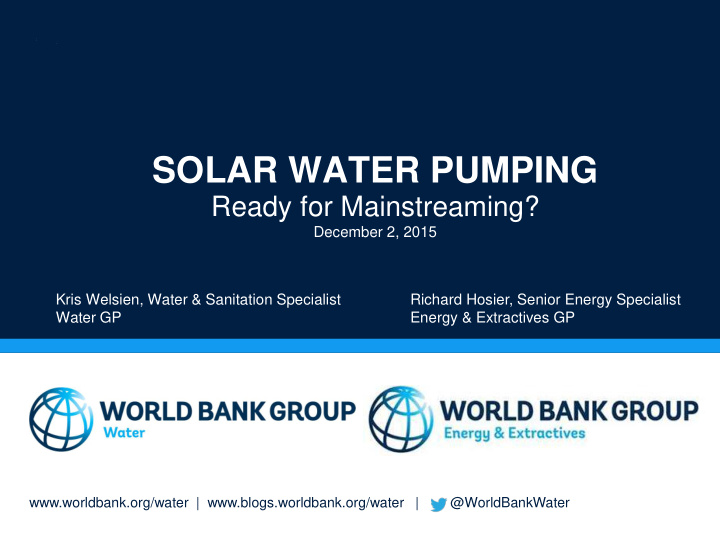



SOLAR WATER PUMPING Ready for Mainstreaming? December 2, 2015 Kris Welsien, Water & Sanitation Specialist Richard Hosier, Senior Energy Specialist Water GP Energy & Extractives GP www.worldbank.org/water | www.blogs.worldbank.org/water | @WorldBankWater
Outline • The Solar PV Market (a disruptive technology?) • Evolution of Solar Pumps • The Technology of Choice • A Pro-Poor Technology? • Challenges and Risks • Mainstreaming Without Piloting • Financing Models • Working Across Practices: Beyond Large Hydro… • Next Steps? 1
The Solar Market: PV Cell Efficiency Risen… 2
The Solar Market: Price of PV Cells Drops 3
The Solar Market: Dramatic Increase in PV Deployment 4
The Solar Market: Price of Silicon Plunges, Accelerating another Price Reduction Cycle 5
Solar PV Price Declines are Compounded by Similar Advances in Other New Technologies • Solar energy has become a disruptive technology opening new market niches • Early PV breakthrough niches were rural energy supply through solar home systems (SHS) — current PV breakthroughs are price-competitive grid-scale PV plants • Lighting Africa: Other new technologies with declining price spirals interact with PV sector, leading to real virtuous cycle of PV-centered technology development • Light-emitting diodes (LEDs) — more light for less electricity spurred innovative lanterns • Mobile Telephony —” Pay-as-you- go” (PAYG) systems facilitating controlling systems and receiving payments remotely — reducing barrier of down payments for SHS 6
The Issue of Storage • Generally, the big challenge for solar remains that the sun does not shine at night which leads to the current focus on energy storage . • In the water sector, solar energy has one key advantage , the issue of storage is solved with one disruptive technology: The Water Tank! 7
Understanding Main Components DC Pump Solar Array Controller 8
Evolution of Solar Pumps Smart Inverters Flex Pumps (DC) Early Solar Pumps 1980 2002 2009 9
Understanding Main Components AC Pump Solar Array Controller/Inverter 10
Should PV Pumping be the technology of choice? 11
Solar Pumps: Widening the Pump Range - 2007 Source: Ratterman, Cohen and Garwood, Solar Pumping Systems (SPS): Introduction and Feasibility Guide, Jan 2007, updated 2011. 12
Solar Pumps: Widening the Range SOLAR PUMPING SYSTEMS Source: Recent analysis from Tanzania, Nov 2015 (forthcoming) 13
Operation and Maintenance Costs SOLAR PUMP DIESEL PUMP Solar System Diesel Generator • • Operation Operation • • OPERATION No operational cost Diesel • • Maintenance Maintenance • • Wipe panels every month 250h minor • • Check wires 1,500h major • • Replacement Replacement • MAINTENANCE Solar Panels: 25 years • 8-12 years • Inverter 8-12 years OPERATION REPLACEMENT MAINTENANCE REPLACEMENT INITIAL INITIAL 14
Life-Cycle Costs Analysis LIFE CYCLE COST OVER 20 YEARS IN US$ For 50m Lift, 20 m 3 /day Flow Diesel The additional costs of diesel pumping have to be covered by the community Is PV a pro-poor technology? PV 15
Risk: Groundwater Depletion Challenge/Risk: Solar pumping may lead to over-irrigation and depleting of groundwater resources through indiscriminate pumping as farmers face no additional costs of pumping water . Potential mitigation measures: – Treat solar power as a “cash crop” and allow farmers to sell surplus power to the grid at an attractive fee-in tariff. In this case the farmers become micro-level Independent Power Producers (IPPs) to the grid. – Future potential: Monitor farmers water usage via remote monitoring features and strengthen the role of groundwater regulators. 16
Operational Challenges Repair and spare parts of solar pumping systems – The inverter needs replacement – Technical capacity of pump operators 17
Lessons from Tanzania – Mainstreaming without Piloting Water Sector Development Program (2007-2014) less than 1% investments in solar. Client: Key Barriers to Solar Pumping: Awareness and Antiquated Perceptions Lack of Technical Capacity on: Design, Security and O&M Limited connections to key private stakeholders 18
Lessons from Tanzania – Mainstreaming without Piloting Mainstreaming PV Pumping: Focused efforts on institutions not pilots! Life Cycle Costs Analysis Awareness and capacity building of National Level Stakeholders Local Level Stakeholders Private Sector Learning Institutions Donor Partners Collaboration with WB energy colleagues Result: Policy Change 19
Potential Financing Models 20
Diesel Scheme Solar Scheme Rural Water Supply: Price Per Bucket of Water Retrofitting existing diesel $2.5 cents/20L $2.5 cents/20L pumping schemes with solar Diesel $1.5 c Repay PV CAPEX $1.5c • Does this open up for a Financing Mechanism? • PAYG – Can we learn from financing schemes for solar home systems? Salaries $0.5 c Salaries $0.5 c Maintenance Maintenance $0.5 c $0.5 c
Financing Models for Solar Pumping On-Grid Off-Grid Rural Water Supply Urban Water Supply • Retrofitting existing • Energy Service Companies diesel pumping schemes and Independent Power with solar Producers (ESCO/IPP) • Financed via a remote • Challenges: mobile-banking pay-as- – Creditworthiness you-go (PAYG) payment – Price of electricity system – Limited private sector capacity • Mimics the payment modality of the diesel scheme 22
Leading Countries • India • Bangladesh • Morocco • Namibia • Uganda 23
Solar for Water Pumping: A low hanging fruit? 24
Working Across Practices: It Makes Sense… Water and Energy share similar sectoral challenges & opportunities — already collaborate on Large Hydro • Shared focus on provision of a basic service to the population (including the poor) in both urban and rural areas • Both Water and Energy missed out on having their own MDG but now have their own SDG (SDG6 and SDG7) • Share a primary client: Public utilities • Share euphemistic terms: e.g. Non-Revenue Water; Losses; Technical and Non-Technical Losses • Both face similar disruptive technological opportunities • Similar analytical tool boxes 25
Working Across Practices: But concretely, How? • Share consultant pool(s): PV experts (pumping, ESCO or otherwise) • Share Business Models: ESCO or WaSCO? • Share Program Approach: Integrated Rural Infrastructure Programs? • Share Network Analyses • Share Financial Instruments: (?) • Plus, Water and Energy Practices are made of really “nice people ”—invite one of “them” for coffee 26
Next Steps? www.worldbank.org/water | www.blogs.worldbank.org/water | @WorldBankWater
Recommend
More recommend